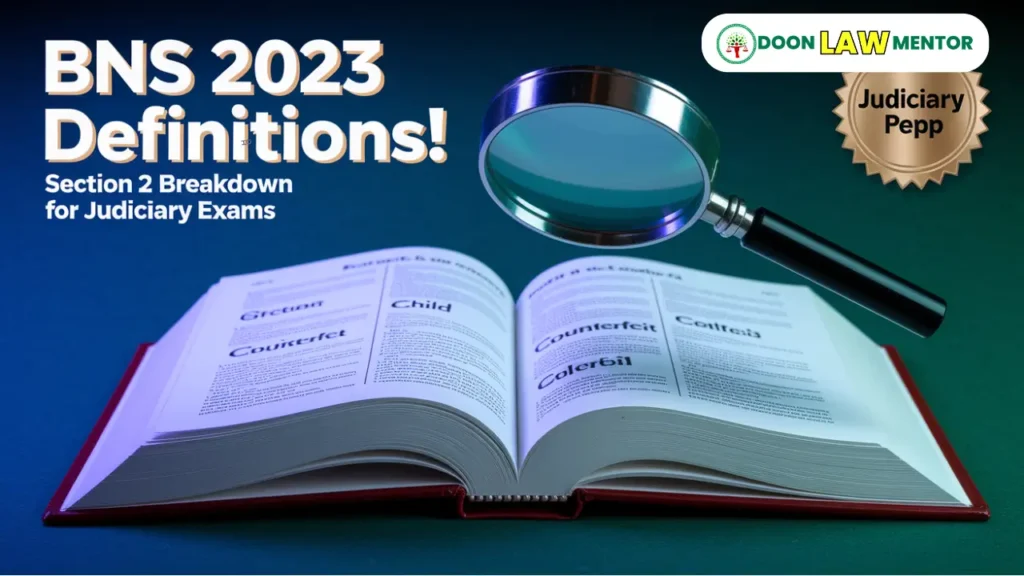The Bharatiya Nyaya Sanhita 2023 (BNS 2023) introduces a consolidated Section 2 for definitions, replacing the scattered structure of the Indian Penal Code (IPC). From “Act” to “Counterfeit”, this blog breaks down key terms like “Child” and “Animal”, offering exam-centric insights for Judiciary, APO, and JLO aspirants preparing for 2025 exams. Learn how to master BNS 2023 definitions with practical tips and strategies.
Table of Contents
Introduction
The Bharatiya Nyaya Sanhita 2023 (BNS 2023), which replaced the Indian Penal Code (IPC) 1860, has introduced a streamlined approach to criminal law in India, with its Section 2 serving as the cornerstone for understanding key legal definitions. In the second lecture of a comprehensive BNS 2023 series, the focus shifts to Section 2, which consolidates all definitions into a single section, unlike the scattered structure of the IPC (up to Section 52A). This lecture provides a bare act-oriented breakdown of critical terms like “Act”, “Animal”, “Child”, and “Counterfeit”, offering exam-centric insights for Judiciary, APO, and JLO aspirants preparing for 2025 exams. This blog explores the BNS 2023 definitions, their legal significance, practical applications, and effective study strategies to master them for competitive exams.
Importance of Section 2: The Foundation of BNS 2023 Definitions
Section 2 of the Bharatiya Nyaya Sanhita 2023 is a pivotal section that consolidates all definitions into a single, accessible framework, a significant improvement over the IPC 1860, where definitions were scattered across multiple sections (from Section 6 to Section 52A). This structural shift simplifies the process of interpreting legal terms, making it easier for Judiciary aspirants, law students, and legal professionals to navigate the law.
Key Features of Section 2
- Consolidated Definitions: Unlike the IPC, which spread definitions across various sections, Section 2 BNS 2023 brings all key terms under one umbrella, with sub-sections like 2(1), 2(2), 2(3), and so on, each defining a specific term.
- Flexibility in Interpretation: The section includes the clause “Unless the context otherwise requires…”, allowing courts to adopt alternative meanings if the general definition does not suit a specific provision’s context. For example, the definition of “Child” in Section 2(3) may be interpreted differently in a provision dealing with child labor versus child trafficking, depending on the context.
- Legal Significance: Definitions in Section 2 are the building blocks for interpreting the entire BNS 2023, as they provide the legal meaning of terms used in subsequent sections, ensuring consistency and clarity in judicial application.
Why It Matters for Aspirants
- Exam Relevance: Definitions are a frequent topic in prelims and mains exams for Judiciary, APO, and UPSC (Law optional), as they test a candidate’s foundational understanding of the law.
- Practical Application: Understanding BNS 2023 definitions is crucial for analyzing hypothetical cases in mains exams or interviews, such as determining whether a series of acts constitutes a single offense under Section 2(1).
- Judicial Interpretation: Courts rely on Section 2 definitions to interpret provisions, making it essential for aspirants to grasp their legal scope and contextual flexibility.
Key Definitions Explained in Section 2 of BNS 2023
The lecture provides a detailed breakdown of several key definitions under Section 2 BNS 2023, highlighting their legal significance, practical applications, and exam relevance:
1. “Act” – Section 2(1)
- Definition: An “Act” includes both a single act and a series of acts.
- Relevance: This definition is crucial for understanding compound offenses or continuous illegal conduct. For example, in a case of extortion under Section 319(2) BNS 2023, a series of threats over time would be considered a single “Act” of extortion.
- Exam Tip: This is a frequently asked question in prelims, as it tests the dual nature of the term (single vs. series). Aspirants should memorize this definition and its application in compound offenses.
- Practical Use: The definition helps determine the scope of liability in cases involving multiple acts, such as conspiracy under Section 61(2) BNS 2023, where a series of actions may constitute a single offense.
2. “Animal” – Section 2(2)
- Definition: An “Animal” is defined as any living creature other than a human being.
- Important Clarification: A dead animal is explicitly excluded from this definition, meaning offenses involving dead animals (e.g., illegal trade of animal parts) may fall under other provisions, such as environmental laws.
- Practical Use: This definition is critical for cruelty-related offenses under Section 324 BNS 2023 (cruelty to animals) or cases involving harm to animals, such as illegal hunting.
- Exam Insight: Aspirants should note the exclusion of dead animals, as this could be a trick question in prelims or mains exams, testing the precise scope of the term.
3. “Child” – Section 2(3)
- Definition: A “Child” is a person below the age of 18 years.
- Key Note: The BNS 2023 uses the term “Child” instead of “minor”, avoiding confusion with definitions under laws like the Guardians and Wards Act, 1890, which may define “minor” differently (e.g., below 21 years for certain purposes).
- Practical Use: This definition is foundational for offenses against children, such as child trafficking (Section 143 BNS 2023) or sexual offenses (Sections 63-72 BNS 2023), ensuring uniform application across provisions.
- Exam Insight: The definition of “Child” is one of the most expected definition-based questions in Judiciary and APO exams, given its relevance to child protection laws.
4. “Counterfeit” – Section 2(4)
- Definition: A person is said to “Counterfeit” when they cause one thing to resemble another, intending to deceive or knowing that deception is likely.
- Legal Highlight: The definition emphasizes intent (mens rea) and knowledge of deception, requiring both elements to establish the offense. For example, creating a fake trademark to deceive consumers would constitute counterfeiting.
- Practical Use: This definition is commonly applied in cases of trademark fraud, forgery (Section 336(3) BNS 2023), and imitation goods, such as counterfeit currency or branded products.
- Exam Tip: Focus on the intent and knowledge aspects, as these are often tested in mains questions involving forgery or deception-based offenses.
Structural Changes: BNS 2023 vs IPC 1860
The Bharatiya Nyaya Sanhita 2023 introduces significant structural changes compared to the IPC 1860, which aspirants must understand to adapt their preparation:
- Consolidated Definitions: The IPC 1860 scattered definitions across Sections 6 to 52A, making it cumbersome to locate key terms. In contrast, Section 2 BNS 2023 consolidates all definitions into a single section, improving accessibility and clarity.
- Reduced Sections: The IPC 1860 had 511 sections, while the BNS 2023 streamlines this to 358 sections, consolidating overlapping provisions and removing outdated ones.
- Revised Chapter Structure: The IPC 1860 had 23 chapters, whereas the BNS 2023 organizes offenses into 20 chapters, with new chapters dedicated to cybercrime, organized crime, and offenses against the state.
- New Terminology: Terms like “Child” replace “minor”, and new definitions for cybercrime and organized crime reflect modern legal needs, requiring aspirants to reorient their understanding.
Exam-Centric Implications
- Forget IPC Sections: Judiciary and APO exams from 2024 onward will be based entirely on the BNS 2023. For example, Section 302 IPC (murder) is now Section 103 BNS 2023, and Section 420 IPC (cheating) is Section 318(4) BNS 2023.
- Focus on New Structure: Aspirants must adapt to the new numerical structure and chapter organization, as questions will test familiarity with BNS 2023 sections and terminology.
- Practical Application: Understanding BNS 2023 definitions is crucial for analyzing hypothetical cases in mains exams, such as determining whether a series of acts constitutes a single offense under Section 2(1).
Learning Strategy to Master BNS 2023 Definitions
To effectively study the BNS 2023 definitions under Section 2, aspirants should adopt a structured and exam-focused approach:
1. Prioritize the Bare Act
- Treat the Bare Act of the Bharatiya Nyaya Sanhita 2023 as your primary resource, as early textbooks may contain errors in interpretation.
- Download the Bare Act from trusted platforms like Doons Law Mentor or official government websites to ensure accuracy.
- Read Section 2 word-for-word, focusing on the legal language and contextual flexibility provided by the clause “Unless the context otherwise requires…”.
2. Focus on Word-by-Word Analysis
- Break down each definition into its component parts, understanding the legal significance of every word. For example, in Section 2(4), the definition of “Counterfeit” hinges on intent to deceive, which is a key element in forgery cases.
- Create a glossary of definitions, noting their sub-section numbers, legal scope, and practical applications in offenses.
- Pay attention to clarifications, such as the exclusion of dead animals from the definition of “Animal” in Section 2(2), as these nuances are often tested in exams.
3. Build Conceptual Clarity
- Avoid rote learning and focus on understanding the context and judicial application of each definition. For example, the definition of “Child” in Section 2(3) is crucial for interpreting child protection laws, such as Section 143 BNS 2023 (child trafficking).
- Use hypothetical scenarios to apply definitions, such as determining whether a series of threats constitutes a single “Act” under Section 2(1) in an extortion case.
- Understand the flexibility provided by the “Unless the context otherwise requires…” clause, as courts may interpret definitions differently based on specific provisions.
4. Prepare for Landmark Cases (Post-Section 2)
- While the lecture focuses on definitions and does not delve into landmark cases, the lecturer notes that case laws will be integrated from Section 3 onward. Aspirants should prepare to study cases that interpret BNS 2023 definitions once they are available.
- For now, focus on conceptual clarity of definitions, as they form the foundation for understanding subsequent provisions and judicial interpretations.
- Keep an eye on recent judgments post-implementation, as they will provide insights into how courts apply Section 2 definitions in real cases.
5. Use Structured Learning Resources
- Attend structured lectures, such as those offered by Doons Law Mentor, which provide a section-by-section breakdown of the BNS 2023, ensuring a comprehensive understanding.
- Leverage demo lectures and downloadable Bare Acts from trusted platforms to supplement your learning.
- Join study groups or online forums to discuss definitions, share notes, and clarify doubts with peers and mentors.
Critical Analysis: A Step Forward in Legal Clarity
The consolidation of BNS 2023 definitions under Section 2 is a significant improvement over the IPC 1860, but it also presents challenges:
- Strengths:
- Simplified Access: Consolidating definitions into a single section makes it easier for Judiciary aspirants and legal professionals to locate and interpret key terms, reducing the complexity of the IPC 1860’s scattered structure.
- Contextual Flexibility: The “Unless the context otherwise requires…” clause allows courts to adapt definitions to specific provisions, ensuring judicial flexibility in interpretation.
- Modern Relevance: Definitions like “Child” and “Counterfeit” reflect contemporary legal needs, addressing issues like child protection and cybercrime-related fraud.
- Challenges:
- Learning Curve: Aspirants accustomed to IPC 1860 definitions must unlearn old terms and adapt to the new structure, which may be challenging initially.
- Judicial Interpretation: The flexibility in interpretation provided by Section 2 may lead to initial inconsistencies until courts establish a body of case law interpreting these definitions.
- Exam Transition: The shift to BNS 2023 requires Judiciary and APO aspirants to reorient their preparation, focusing on new terminology and section numbers, which may cause confusion in the short term.
Overall, Section 2 BNS 2023 is a foundational step toward a more accessible and modern criminal justice system, but its success will depend on how effectively law students, aspirants, and legal professionals adapt to the new framework.
Relevance for Judiciary, APO, and JLO Aspirants
The BNS 2023 definitions under Section 2 are a critical topic for Judiciary, APO, and JLO aspirants preparing for 2025 exams:
- Prelims: Expect questions on key definitions like “Act” (Section 2(1)), “Animal” (Section 2(2)), “Child” (Section 2(3)), and “Counterfeit” (Section 2(4)), as well as the structural changes (e.g., 358 sections, 20 chapters).
- Mains: Write essays on topics like “Role of Definitions in Interpreting BNS 2023” or “BNS 2023 vs IPC 1860: Structural Changes,” using Section 2 definitions to analyze their legal significance and practical applications. Discuss how definitions like “Child” impact child protection laws.
- Interviews: Discuss the importance of Section 2 BNS 2023 in ensuring legal clarity, its role in judicial interpretation, and the challenges of transitioning from the IPC 1860, showcasing a deep understanding of the new law.
Conclusion
The Bharatiya Nyaya Sanhita 2023 introduces a streamlined approach to criminal law with its Section 2, consolidating all definitions into a single, accessible framework. Key terms like “Act”, “Animal”, “Child”, and “Counterfeit” provide the foundation for interpreting the law, offering legal clarity and contextual flexibility through the “Unless the context otherwise requires…” clause. For Judiciary, APO, and JLO aspirants, mastering these BNS 2023 definitions is non-negotiable, as they will form the basis of prelims, mains, and interviews in 2025 exams. By prioritizing the Bare Act, focusing on word-by-word analysis, and building conceptual clarity, aspirants can navigate this transition effectively, preparing for a future shaped by a modern, justice-oriented criminal justice system.
Call-to-Action
Master BNS 2023 definitions for your 2025 exams! Join Doon Law Mentor’s Courses for expert guidance. Follow @doonlawmentor on Instagram for daily legal updates!
FAQs
- What is Section 2 of the Bharatiya Nyaya Sanhita 2023?
Section 2 BNS 2023 consolidates all definitions into a single section, unlike the scattered structure of the IPC 1860, providing clarity for legal interpretation. - How does BNS 2023 differ from IPC 1860 in terms of definitions?
The BNS 2023 consolidates definitions in Section 2, while the IPC 1860 scattered them across Sections 6 to 52A, making BNS more accessible. - What does the definition of “Act” mean in BNS 2023?
Under Section 2(1) BNS 2023, an “Act” includes both a single act and a series of acts, relevant for compound offenses. - How is “Animal” defined in BNS 2023?
Section 2(2) BNS 2023 defines an “Animal” as any living creature other than a human, excluding dead animals. - What is the definition of “Child” in BNS 2023?
Section 2(3) BNS 2023 defines a “Child” as a person below 18 years, using “Child” instead of “minor” to avoid confusion. - What does “Counterfeit” mean in BNS 2023?
Section 2(4) BNS 2023 defines “Counterfeit” as causing one thing to resemble another with intent to deceive, relevant for forgery cases. - Why are BNS 2023 definitions important for Judiciary exams?
BNS 2023 definitions are tested in prelims and mains, as they form the foundation for interpreting criminal law provisions in 2025 exams. - How many sections does the BNS 2023 have compared to the IPC?
The BNS 2023 has 358 sections, compared to 511 sections in the IPC 1860, with a streamlined structure. - How should aspirants study BNS 2023 definitions?
Use the Bare Act, focus on word-by-word analysis, build conceptual clarity, and attend structured lectures to master BNS 2023 definitions. - What is the significance of the “Unless the context otherwise requires…” clause?
This clause in Section 2 BNS 2023 allows courts to adapt definitions to specific provisions, ensuring judicial flexibility in interpretation.
#BNS2023Definitions, #JudiciaryExams, #BharatiyaNyayaSanhita, #LawStudents #doonlawmentor #doonlawmentorbns #newcriminallaws







